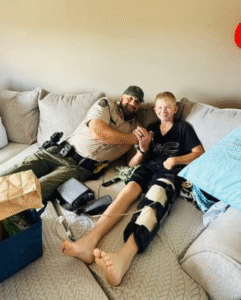🚨 A Deputy’s Hand in the Dirt: Compassion in the Face of Chaos
In the world of law enforcement, heroism is often measured in arrests, rescues, and split-second decisions. But sometimes, it’s found in something quieter — a hand in the dirt, a voice in the dark, a presence that steadies a soul in its most fragile moment. That’s the kind of heroism Deputy AJ Rees embodied when he knelt beside 13-year-old Mason Skees, broken and bleeding after a devastating dirt bike crash, and simply held his hand.
It wasn’t protocol. It wasn’t dramatic. But it was everything.
🏍️ The Crash That Changed Everything
For Mason, it was supposed to be another day of freedom — wind in his face, adrenaline in his chest, the kind of joy that only a dirt bike and open terrain can deliver. But in a single, brutal moment, that joy turned to agony. Mason lost control of his bike, and the crash that followed shattered his femur — the strongest bone in the human body — into more than 50 pieces.
The pain was immediate and overwhelming. Blood pooled around him. His vision blurred. Fear surged. And then, through the haze, came a figure — not towering above him, but lying beside him.
Deputy AJ Rees didn’t shout orders or stand back. He got down in the dirt. He took Mason’s hand in his own. And he spoke — calmly, steadily, with the kind of presence that anchors a person when everything else is slipping away.
🤝 The Power of Presence
In moments of crisis, the human brain searches for something to hold onto — a voice, a touch, a sign that we’re not alone. Rees gave Mason that lifeline. He didn’t try to fix the injury. He didn’t pretend everything was okay. He simply stayed.
And Mason, despite the agony, never shed a tear. He held on — physically and emotionally — to the deputy beside him. That connection, forged in blood and dirt, became a bridge between despair and survival.
When medical crews arrived, Mason was rushed away, fighting to stay conscious. What followed was a medical marathon: four surgeries, blood loss stabilization, and a painstaking reconstruction of his shattered leg.
But he survived. And more than that — he endured.
🏥 Recovery and Reunion
Nine days later, Mason returned home. He carried scars, pain, and the weight of a long road ahead. But he also carried something else: hope. And that hope deepened when Deputy Rees came to visit — not in uniform, not with sirens, but with snacks, an Xbox gift card, and a donation from his church community to help the family through tough times.
It wasn’t the material gifts that mattered most. It was the gesture. The continuity. The reminder that the bond formed in trauma hadn’t been forgotten.
As they sat together, their hands found each other again — just like they had in the dirt. Only now, the gesture carried a different weight. It wasn’t about survival. It was about encouragement. It wasn’t about fear. It was about friendship.
🧠 The Psychology of Crisis Connection
Psychologists call it “emotional anchoring” — the phenomenon where a person in distress attaches to a calm, present figure as a way to regulate fear. In trauma response, this can be life-saving. It lowers cortisol levels, stabilizes breathing, and helps the brain reorient itself.
Deputy Rees didn’t need a degree in psychology to know that. He just needed empathy.
His decision to lie beside Mason, to meet him at eye level, was more than comforting. It was strategic. It gave Mason something to focus on besides pain. It gave him a reason to hold on.
And that kind of connection doesn’t fade. It imprints.
👮♂️ The Badge and the Burden
For Rees, the moment was a reminder of why he wears the badge. Not just to enforce laws, but to be a steady hand in moments of chaos. To show humanity when it’s needed most.
Law enforcement officers are often portrayed in extremes — either as heroes or villains. But the truth is more nuanced. Many deputies, like Rees, operate in the quiet middle: responding to accidents, comforting victims, making split-second decisions that never make headlines.
This story, however, did make headlines — and rightly so. Because it reminds us that heroism isn’t always loud. Sometimes, it’s a hand in the dirt.
🌱 Growth After Trauma
Mason’s journey is far from over. Physical therapy, emotional healing, and the psychological aftermath of such a traumatic event will take time. But he’s not walking that path alone.
The bond with Rees has become a source of strength — a reminder that even in the darkest hour, someone showed up. Someone stayed. Someone cared.
And that kind of memory becomes a seed. It grows into resilience. It shapes how we see the world. It teaches us that compassion can be found in the most unexpected places — even on the side of a dirt trail, in the hands of a stranger.
🕊️ Final Reflections: Humanity in Uniform
“A Deputy’s Hand in the Dirt” isn’t just a headline. It’s a metaphor. It’s a story about what happens when duty meets empathy, when protocol gives way to presence, and when a uniform becomes a vessel for humanity.
In a world often divided by fear, mistrust, and misunderstanding, stories like this remind us of what’s possible. They show us that connection can be forged in crisis. That healing begins with compassion. And that sometimes, the most powerful thing you can do is simply lie down beside someone and say, “I’m here.”
Mason Skees will carry that moment with him forever. And so will Deputy AJ Rees.
Because in that moment — in the dirt, in the pain, in the silence — something sacred happened.
And it changed both of them.


